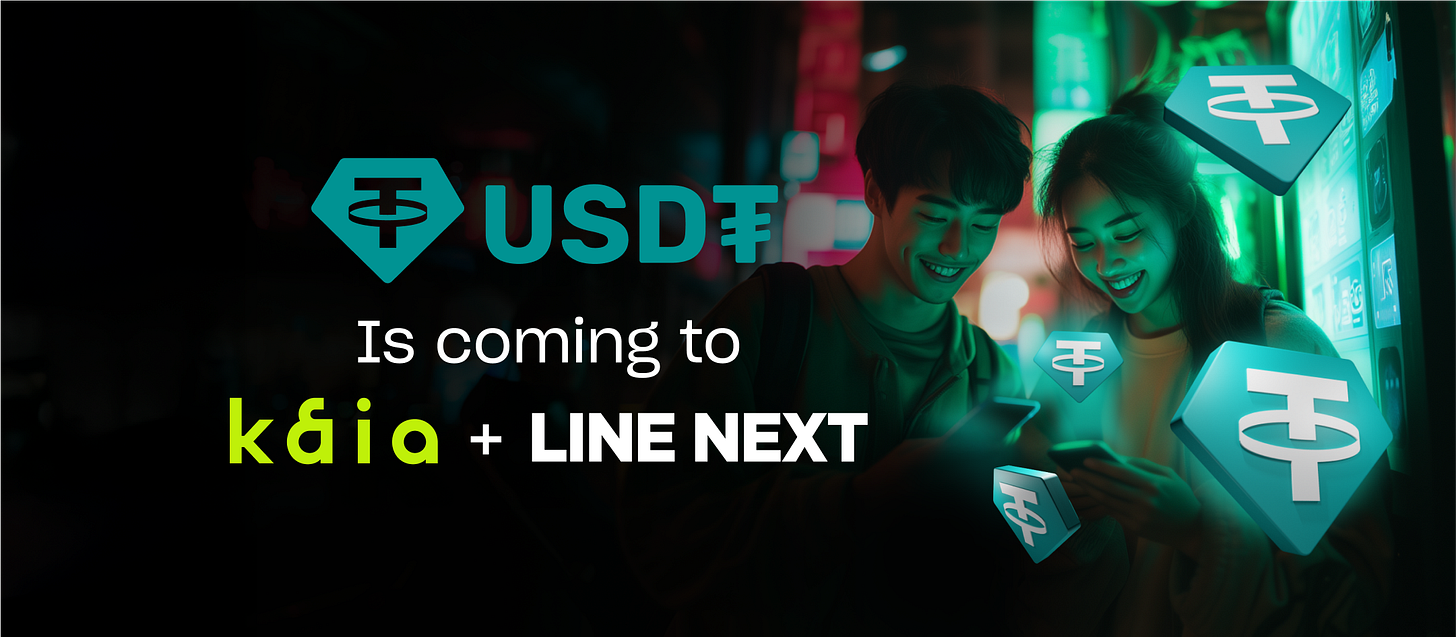Tether x Kaia: A Practical Step Toward Real-World Distribution
If you've been around crypto long enough, you learn to filter out the noise. A lot of partnerships are just that….headlines designed to impress investors or stir up some short-lived hype amongst “armies”. But every now and then, something lands with longer-term implications.
That’s what this latest announcement from Tether looks like.
USDT will now be natively deployed on the Kaia blockchain (formerly Klaytn), in collaboration with LINE NEXT. LINE is one of Asia’s largest messaging platforms, with over 170 million monthly active users across Japan, Taiwan, Thailand, and Indonesia.
This integration brings USDT into LINE’s Mini Dapp platform and self-custodial wallet, enabling in-app payments, cross-border transactions, and access to DeFi tools; all within an app many users already rely on. In effect, this puts stablecoins into the day-to-day flow of mobile users across Asia. For Tether, this allows them to deepen access in regions where stablecoins are more of a utility than a narrative. And it happens outside the purview of U.S. politics or EU regulatory cycles.
On a personal note, I met Jaesun Han, CEO of Klaytn, during an event at the Web3 Festival in Hong Kong back in April 2024. We spoke about the Kaia strategy, the LINE partnership, and their user base. What stood out was the seriousness with which they approached user distribution and product design. It felt less like a crypto company chasing buzzwords and more like a tech team working toward something durable.
That’s important context for this partnership. Because what we’re seeing with Kaia, LINE, and Tether is a bullish signal of Web2 meeting Web3, not through surface-level integrations, but through native infrastructure alignment. Like a convergence of distribution and utility. Web2 companies like LINE have massive built-in user networks and interface dominance, while Web3 infrastructure like Kaia and USDT brings composability and financial self-custody.
If you’ve ever used WeChat in China, you’ll understand the endgame. WeChat is 1000x more than messaging….it’s payments, banking, shopping, even access to government services. It’s a parallel digital layer woven directly into society. And what’s happening now with LINE and Tether might be an early signal that crypto, finally, is building something similar: user-first, invisible finance, natively embedded into apps that already run people’s lives.
We’ve seen it before, Telegram integrating with the TON ecosystem and acting as a massive distribution funnel for crypto-native products. The difference is: LINE already has regional penetration and digital payments familiarity baked in. So USDT doesn’t feel like a bolt-on feature. You could almost say that it’s a natural extension…
As the stablecoin industry becomes more competitive, more regulated, and more accepted as a serious industry, the companies that win won’t just be the ones with regulatory blessings or deep reserves. They’ll be the ones who understand how to tap into existing user networks; and meet people where they already are.
That’s the best way I can summarize what this Kaia and Tether collaboration reflects.
Yet another reminder that the stablecoin wars won’t just be fought on compliance papers or (Ethereum) block explorers. They’ll be fought but predominantly won through integrations that feel invisible; until they're everywhere.
I love stablecoins, Tether in particular, and I will be writing about the ongoing and ever-increasing future stablecoin war. Stay tuned for insights, drama, and analysis as it all unfolds.
P.S. In case you didn’t realize, I am not Patrick Hansen


